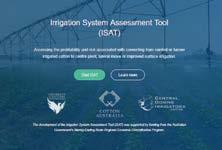
3 minute read
FEATURE ARTICLES
TABLE. ANALYSIS OF POTENTIAL IMPROVEMENTS USING OPTIMISED FURROW IRRIGATION AND LATERAL MOVE COMPARED WITH RAINFED CROPPING BASED ON AN ANNUAL WATER ALLOCATION OF 3.5 ML/HA.
Scenario
Optimised furrow
Gross margin ($/ha/ yr) Median yield cotton (b/ha), barley (t/ha) Application efficiency for irrigation (%)
$494
$2,471
$2,831 Cotton: 4.6 Barley: 1.9 Cotton: 12.2 Barley: 4.5
Cotton: 13.4 Barley: 6.4 65%
85%
Capital investment $/ha Increase in ross margin with new irrigation equipment ($/ha/yr) -
Benefit cost ratio
$1,000
$1,800 $1,977
$2,337 27.7
16.1
IRR (%)
198%
130%
The overall pumping costs used with the lateral move were $47/ML compared to $29/ML for the furrow system, given higher pump pressures. Labour costs for the lateral move were significantly lower.
The lateral move resulted in a higher increase in gross margin ($2,337/ha/year) compared to furrow irrigation ($1,977/ha/year) given better yields. However, the higher capital investment resulted in a lower benefit-cost ratio and IRR. Both systems provided a very good return on investment.
The bottom line After he used ISAT, Ian Hayllor identified its key benefits for him.
“The tool is very useful to look at a range of scenarios, test assumptions, for example the impact of reduced water allocation or capital cost, and guide investment decisions,” he said.
The ISAT tool allows assessment of the impact of a range of water allocation scenarios on profitability. The sensitivity of changes in cost of labour and energy can also be assessed. Field shape can also be taken into consideration when comparing systems as some systems (e.g. centre pivot) may not allow the full area to be irrigated.
ISAT project funding ISAT was commissioned by Cotton Australia and was funded through Queensland Department of Natural Resources, Mines and Energy (DNRME) and Cotton Australia under the Murray-Darling Basin Regional Economic Diversification Program.
Free download. ISAT is available, free of charge, to irrigators via the link https://isat.usq.edu.au
Erik Schmidt and Joseph Foley, USQ Centre for Agricultural Engineering, Toowoomba
HOW THE NATION’S BUSHFIRE CRISIS COULD BECOME A WATERWAYS CRISIS
In January this year a paper highlighting the dangers of Australia’s recent bushfire crisis turning into a waterways crisis was published by Adjunct Professor Max Finlayson from Charles Sturt University’s Institute for land, Water and Society and Jason Alexandra from RMIT.
“Floods after bushfires: rapid responses for reducing impacts of sediment, ash, and nutrient slugs” was published online in the Australasian Journal of Water Resources and urges immediate action to minimise the impact of fires on Australian waterways.
The paper describes the risks posed to waterways, catchments, wetlands, lakes, and estuaries when rainfall washes silt and ash into them. Fire-affected areas are susceptible to erosion so heavy rain could wash sediment, ash, and nutrients into waterways.

The result is potential algal blooms, problems for urban water supplies, and fish kills.
The article identifies four focus areas: • assessing the risk and options for co-ordinated policy responses • making water supplies a priority for assessment and treatment • identifying important habitat areas and at-risk species of fish • increasing monitoring and health warnings for the public.
Professor Finlayson said investing in water supplies and quality benefits human health and reduces economic loss. Quick reaction will ensure the bushfire crisis does not become a waterways crisis.
“There are short-term, medium-term, and long-term considerations for post-fire recovery,” he said.
“State and Commonwealth governments need to use past experiences and the information gathered during this crisis to design and co-ordinate recovery programs to ensure the longevity of our waterways after bushfires.”
Information. To download the paper, go to website https://www.tandfonline.com/doi/full/ 10.1080/13241583.2020.1717694










